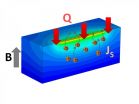(Press-News.org) CAMBRIDGE, Mass. -- John Leonard's group in the MIT Department of Mechanical Engineering specializes in SLAM, or simultaneous localization and mapping, the technique whereby mobile autonomous robots map their environments and determine their locations.
Last week, at the Robotics Science and Systems conference, members of Leonard's group presented a new paper demonstrating how SLAM can be used to improve object-recognition systems, which will be a vital component of future robots that have to manipulate the objects around them in arbitrary ways.
The system uses SLAM information to augment existing object-recognition algorithms. Its performance should thus continue to improve as computer-vision researchers develop better recognition software, and roboticists develop better SLAM software.
"Considering object recognition as a black box, and considering SLAM as a black box, how do you integrate them in a nice manner?" asks Sudeep Pillai, a graduate student in computer science and engineering and first author on the new paper. "How do you incorporate probabilities from each viewpoint over time? That's really what we wanted to achieve."
Despite working with existing SLAM and object-recognition algorithms, however, and despite using only the output of an ordinary video camera, the system's performance is already comparable to that of special-purpose robotic object-recognition systems that factor in depth measurements as well as visual information.
And of course, because the system can fuse information captured from different camera angles, it fares much better than object-recognition systems trying to identify objects in still images.
Drawing boundaries
Before hazarding a guess about which objects an image contains, Pillai says, newer object-recognition systems first try to identify the boundaries between objects. On the basis of a preliminary analysis of color transitions, they'll divide an image into rectangular regions that probably contain objects of some sort. Then they'll run a recognition algorithm on just the pixels inside each rectangle.
To get a good result, a classical object-recognition system may have to redraw those rectangles thousands of times. From some perspectives, for instance, two objects standing next to each other might look like one, particularly if they're similarly colored. The system would have to test the hypothesis that lumps them together, as well as hypotheses that treat them as separate.
Because a SLAM map is three-dimensional, however, it does a better job of distinguishing objects that are near each other than single-perspective analysis can. The system devised by Pillai and Leonard, a professor of mechanical and ocean engineering, uses the SLAM map to guide the segmentation of images captured by its camera before feeding them to the object-recognition algorithm. It thus wastes less time on spurious hypotheses.
More important, the SLAM data let the system correlate the segmentation of images captured from different perspectives. Analyzing image segments that likely depict the same objects from different angles improves the system's performance.
Picture perfect
Using machine learning, other researchers have built object-recognition systems that act directly on detailed 3-D SLAM maps built from data captured by cameras, such as the Microsoft Kinect, that also make depth measurements. But unlike those systems, Pillai and Leonard's system can exploit the vast body of research on object recognizers trained on single-perspective images captured by standard cameras.
Moreover, the performance of Pillai and Leonard's system is already comparable to that of the systems that use depth information. And it's much more reliable outdoors, where depth sensors like the Kinect's, which depend on infrared light, are virtually useless.
Pillai and Leonard's new paper describes how SLAM can help improve object detection, but in ongoing work, Pillai is investigating whether object detection can similarly aid SLAM. One of the central challenges in SLAM is what roboticists call "loop closure." As a robot builds a map of its environment, it may find itself somewhere it's already been -- entering a room, say, from a different door. The robot needs to be able to recognize previously visited locations, so that it can fuse mapping data acquired from different perspectives.
Object recognition could help with that problem. If a robot enters a room to find a conference table with a laptop, a coffee mug, and a notebook at one end of it, it could infer that it's the same conference room where it previously identified a laptop, a coffee mug, and a notebook in close proximity.
INFORMATION:
Additional background
ARCHIVE: Object recognition for free
ARCHIVE: Vision system for household robots
ARCHIVE: In one aspect of vision, computers catch up to primate brain
This news release is available in Spanish.
Since 2006, the team of researchers has sequenced the mitochondrial DNA of all the known species of butterflies in the Iberian peninsula (228) and its main populations. The result is a report that compiles more than 3500 genetic sequences of all the species, which have been compared to the genetic sequences of other European populations. The paper has 277 pages of supplementary material, including pictures and 80 maps of the geographical distribution of the butterfly genetic lineages identified.
This is the first time ...
(Philadelphia, PA) - Patients who have lower extremity proximal deep vein thrombosis (LE-DVT), or a blood clot in their leg, are increasingly undergoing minimally invasive catheter-based blood clot removal - also referred to as catheter-directed thrombolysis (CDT) - rather than solely being treated with traditional blood-thinning medications (anticoagulation alone). This trend is due to recent literature showing reductions in lifestyle-limiting post-thrombotic complications of acute DVT in patients who undergo CDT compared to those that are treated with anticoagulation ...
This news release is available in German.
Pathogenic bacteria develop killer machines that work very specifically and highly efficiently. Scientists from the University of Freiburg have solved the molecular mechanism of a fish toxin that could be used in the future as a medication to treat cancer. The scientists have now published their research in the journal Nature Communications.
The Yersinia species of pathogens can cause the bubonic plague and serious gastrointestinal infections in humans. The pharmacologist Dr. Thomas Jank and his fellow researchers in the ...
La Jolla, Calif., July 23, 2015 - A new study by researchers at Sanford Burnham Prebys Medical Discovery Institute (SBP), the National Cancer Institute, and the Chulabhorn Research Institute has found that blocking the activity of a key immune receptor, the lymphotoxin-beta receptor (LTβR), reduces the progression of liver cancer. The results, published today in the online edition of Gut, could provide new treatment strategies for the disease, which is the third leading cause of cancer-related deaths worldwide.
"Our findings point to a new way to improve the treatment ...
After decades of overtreatment for low-risk prostate cancer and inadequate management of its more aggressive forms, patients are now more likely to receive medical care matched to level of risk, according to a study by researchers at UC San Francisco.
In the first study to document updated treatment trends, researchers found that from 2010 to 2013, 40 percent of men with low-risk prostate cancer opted for active surveillance, in which the disease is monitored closely with blood tests, imaging studies and biopsies. Treatment is deferred unless these tests show evidence ...
Today an international team of astronomers from NASA's Kepler mission have announced the discovery of a near-Earth-sized planet in the habitable zone of a Sun-like star.
Dr Daniel Huber from the University of Sydney's School of Physics is part of the team which made the discovery with NASA's Kepler Space Telescope.
The planet named Kepler-452b is 60 per cent larger than Earth and orbits a Sun-like star with an orbital period of 385 days.
The mere 20 day difference between the planet's orbital period and that of Earth's makes it the closest analogue to Earth ever ...
EU's grid connected cumulative capacity in 2014 reached 129 GW, meeting 8% of European electricity demand, equivalent to the combined annual consumption of Belgium, the Netherlands, Greece and Ireland. According to a JRC report, the impressive growth of the industry will allow at least 12% electricity share by 2020, a significant contribution to the goal of the European energy and climate package of 20% share of energy from renewable sources.
The 2014 JRC wind status report presents the technology, market and economics of the wind energy sector with a focus on the EU. ...
Scientists at the University of York believe they have identified how some tiny regulatory molecules in cells can make prostate cancers resistant to radiotherapy.
It is hoped that this new development could pave the way for more effective treatments - allowing a lower dose of radiotherapy to be used while prolonging the lives of thousands of men.
Prostate cancer is the most commonly diagnosed form of male cancer in the UK and kills more than 11,000 men every year.
In the latest studies, published in European Urology and the British Journal of Cancer, scientists in The ...
July 24, 2015 - Patient satisfaction ratings after surgery for spinal degenerative disease--especially in terms of reduced pain and disability--are a good indicator of the procedure's effectiveness, reports a study in the August issue of Neurosurgery, official journal of the Congress of Neurological Surgeons. The journal is published by Wolters Kluwer.
"Patient satisfaction with outcome may accurately represent the effectiveness of surgical spine care in terms of one-year improvement in pain and disability," according to the new research by Dr. Clinton J. Devin of Vanderbilt ...
It doesn't happen often that a young scientist makes a significant and unexpected discovery, but postdoctoral researcher Stephen Wu of the U.S. Department of Energy's Argonne National Laboratory just did exactly that. What he found--that you don't need a magnetic material to create spin current from insulators--has important implications for the field of spintronics and the development of high-speed, low-power electronics that use electron spin rather than charge to carry information.
Wu's work upends prevailing ideas of how to generate a current of spins. "This is a ...



